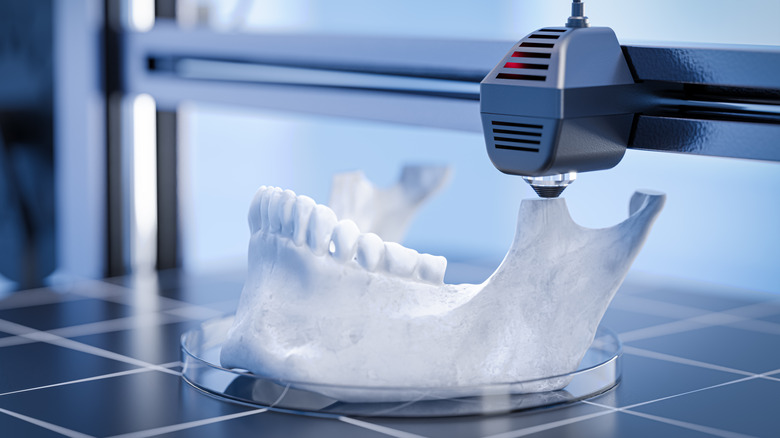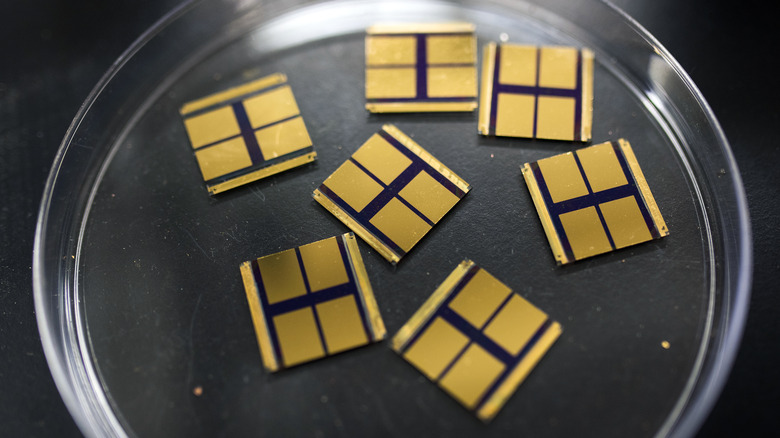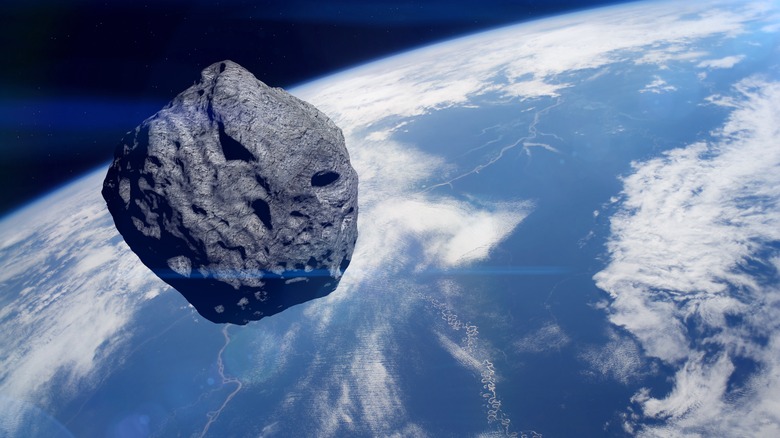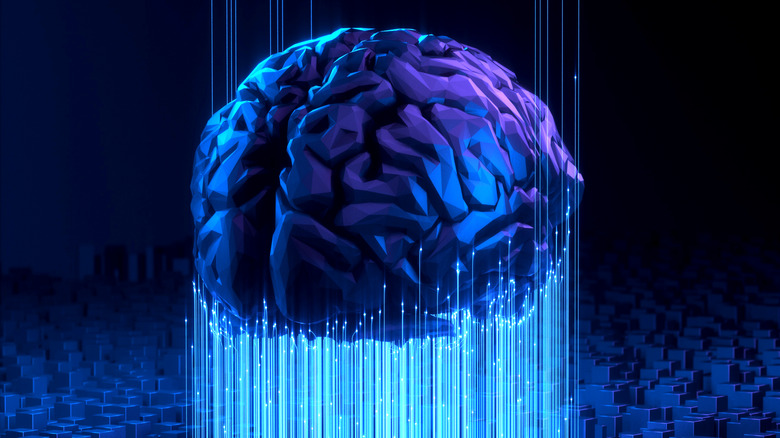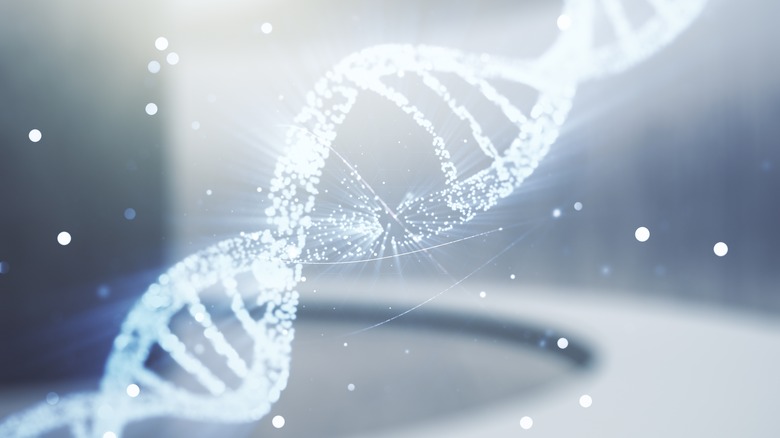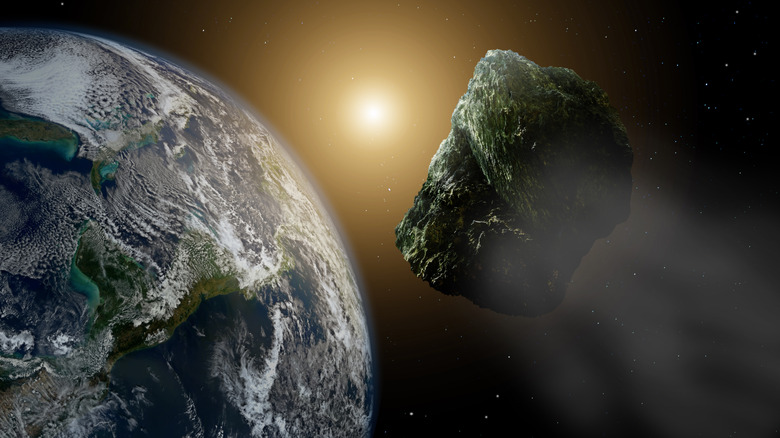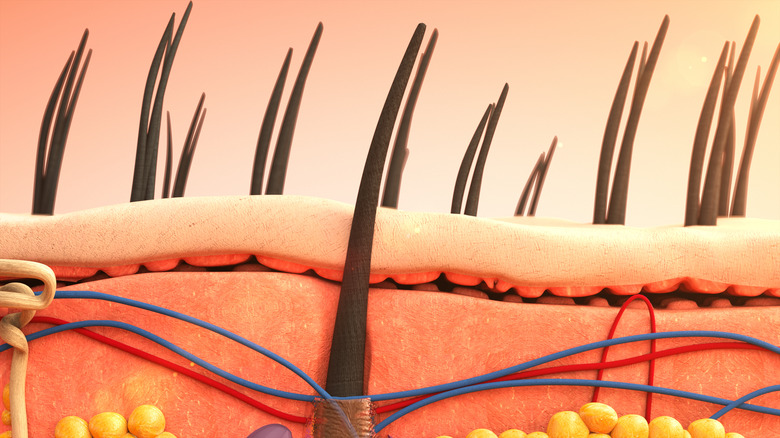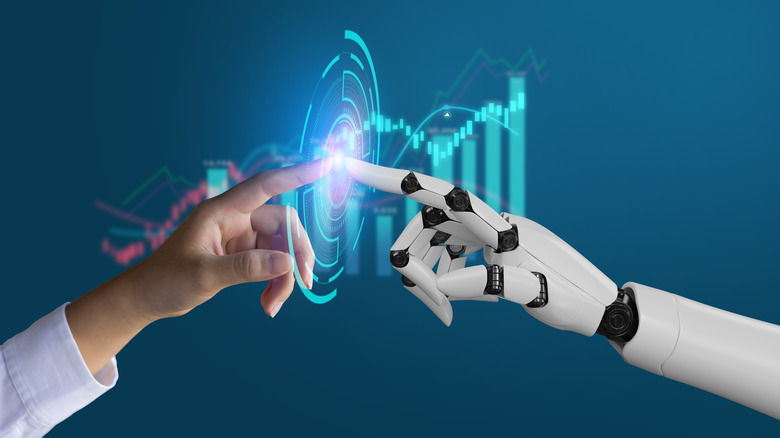The Biggest Scientific Discoveries Of 2023
Every year, scientists make breakthroughs in all manner of important fields, and 2023 was no different. In a society in which everyone has powerful computers in their pockets, some cars can drive themselves (yet still not fly), and merely mentioning a product to the right device can cause it to show up on your doorstep, it's getting harder and harder to be surprised — but the scientific strides made in 2023 may still have some jaws on the floor and eyes popping comically out of heads.
With the advent of the artificial intelligence-powered chatbot ChatGPT, AI was big news in '23, and that particular field generated even more fascinating innovations that you may not yet be aware of. But pretty much all of the scientific disciplines took their turns kicking butt and taking names throughout the year, from paleontology to biology to computing, and many of the advances that were made could have profound implications for the future. So, without any further ado, let's dive into them — the biggest scientific discoveries of 2023.
Possibly the first-ever writing
Archaeologists have been discovering cave drawings since time immemorial, but identifying anything resembling an actual system of writing used by our ancient ancestors has remained elusive. Some indications have been found, however; for well over a century, scientists have documented what appears to be a set of markings, accompanied by drawings of animals as old as 37,000 years, appearing in cave systems across Europe. Until recently, what these markings might mean was anyone's guess — but in January 2023, a study published in the Cambridge Archaeological Journal may have finally pinned down their purpose.
Researchers compared the symbols to the birth cycles of the animals depicted in the drawings and the 13 annual lunar cycles, and astonishingly, a pattern was found. It indicated that the markings might actually be an extremely early — perhaps the earliest — notational system, one which pertains to the mating and birth cycles of species that would have been our ancestors' prey. In particular, one symbol resembling the letter "Y" seemed to correlate to birth, the first known instance of such a correlation in cave markings.
It's not simply an interesting discovery; it suggests that early humans may have been capable of more advanced cognition than previously thought. "This is a really big deal cognitively," said Ben Bacon, a researcher and co-author of the study. "We're dealing with a system that has intense organization, intense logic to it." He further explained that the system's basis on lunar cycles made it "universal ... if you migrate from the Pyrenees to Belgium, you can just use the same calendar."
A potential fountain of youth
Back in 2012, Japanese biologist Shinya Yamanaka won a share of the Nobel Prize in Physiology or Medicine. It was for his part in discovering a series of proteins capable of reconfiguring your average, everyday cells, turning them into super-versatile stem cells, which almost certainly have far more therapeutic uses than have been discovered yet.
Over a decade later, a pair of teams from the United States reported on processes that employed these protein cocktails, known as "Yamanaka factors," in gene therapy treatments, that proved to have a very interesting effect on mice in the lab. "These studies," explained University of Washington scientist Matt Kaeberlein to the journal Science, "use reprogramming factors to reverse epigenetic changes that happen during aging" — an effect that has the potential to one day dramatically extend the lifespan of humans, or even turn back the clock on old age.
To be sure, the technology is still in its infancy (no pun intended), but the results of the twin studies are fascinating; one study (via Biorxiv), from the biotech company Rejuvenate Bio in San Diego, California, claimed to effectively double the life expectancy of elderly mice using the therapy. The other (via Cell), spearheaded by the somewhat controversial Harvard geneticist David Sinclair, lent credence to Sinclair's hypothesis that the effects of aging are due to a specific type of deterioration of DNA, reversing some of those effects by repairing the deterioration using Yamanaka factors. The tech has a long way to go before it can be applied to a potential fountain of youth — but these early results show that the potential is real.
Miniature liquid metal robots that can support 30 times their weight
If the phrase "liquid metal robot" may call to mind an image of actor Robert Patrick in a police uniform, but the versions presented by researchers at Pennsylvania's Carnegie Mellon University in January 2023 looked nothing like time-traveling shapeshifting cops; they were extremely tiny, activated to change states by magnetic fields, and capable of performing delicate tasks in both mechanical and medical capacities.
Composed of the liquid metal gallium and extremely tiny particles of an alloy, the robots are capable of supporting 30 times their weight when solid — but when exposed to magnetism, they turn to puddles that can be pushed, pulled, and stretched to perform tasks via manipulation of the magnetic field. According to Cell, these tasks included maneuvering a small light bulb to a circuit board, then attaching it by melting over it and providing a current; navigating to a foreign substance inside an artificial stomach, melting over it, and hauling it out; and transforming into the shape of a tiny man, then liquefying to slip between the bars of a tiny jail cell. (No, really. They actually made it do this.)
A foolproof method of precisely tracking the little guys' location will have to be developed before they can be deployed in medical procedures — but when it comes to other uses, such as performing minor mechanical procedures on spacecraft, the tech is essentially ready to go.
A new basis for 6G wireless networks
When it comes to wireless networks and, well, electronics in general, a large part of developing greater speed and efficiency comes down to miniaturization. Simply put, the smaller electronic components can be made while retaining their power and efficiency, the better — and in the case of wireless networks, smaller signal wavelengths translate to faster data transmission. Given how tiny yet powerful electronic devices have become, though, it may not shock you to learn that miniaturization has pretty much hit a wall — which is where the concept of the "metadevice" comes into play, a concept which will potentially form the foundation of the sixth generation (6G) of wireless protocols.
Without going full egghead, the general principle is this: metadevices are basically conventional semiconductors adorned with "metastructures," which are contacts etched into their surfaces in microscopic patterns shorter than the device's wavelength output. These metastructures allow for manipulation of the electrical fields within the semiconductor, forcing it to output frequencies in the terahertz range — which, for those keeping score at home, is way, way faster than the gigahertz-range frequencies employed by common wireless devices.
As reported by EPFL, Ph.D. student Mohammad Samizadeh Nikooby — the co-author of the study published in Nature – said, "This new technology could change the future of ultra-high-speed communications, as it is compatible with existing processes in semiconductor manufacturing." The next step: the engineering of other electrical components compatible with this new wave of semiconductors.
A living 3-D printable ink
3-D printing is a marvelous recent technology that has led to advances in architecture, irrigation, health care, and a slew of other fields. In a nutshell, 3-D printers use a layering process to "print" entire objects out of special "ink." But since its inception, it has suffered from a specific limitation: the ink. Due to the fact that it must behave as both a liquid and a solid, the end products of the 3-D printing process can often be too brittle or too malleable — but in February 2023, researchers at EPFL's School of Engineering published a study in Materials Today which details a novel solution to the problem.
That solution is living bacteria, Sporosarcina pasteurii, the critical ingredient in what the team calls "BactoInk." The special ink can be used in any standard 3-D printer, and no special printing process is needed — but the finished product, once treated with a solution, mineralizes and hardens over several days. Once the process is complete, the mineral content of the object stands at over 90 percent — rendering it far more durable than conventional 3-D printed objects. The team foresees potential uses in the medical field, in the restoration of delicate artworks such as sculptures and vases, and — perhaps most intriguingly — the possibility of 3-D printing artificial coral reefs, which could help to repair damaged marine ecosystems.
A gel that grows electrodes in living organisms
The use of electrodes in medical technology, which are used to artificially stimulate nerves, muscles, and even the brain, can be akin to a double-edged sword — literally, in a way. No matter the materials they are made from, none are soft enough to completely mitigate the risk of damage to soft tissues, or the irritation and inflammation of those tissues, which can affect the performance of the electrode.
In February 2023, though, researchers at Sweden's Linköping University published a study in Science that suggests that those issues may soon be a thing of the past. It describes the composition of a special gel that, when injected into the target area, metabolizes the body's own sugars to transform it into an ultra-soft, flexible electrode that carries all of the zap, so to speak, with none of the risk.
The team used the technique on two different organisms for different purposes: the soft electrodes were successfully grown in the hearts, tail fins, and brains of Zebrafish to stimulate those organs and muscles, and the process was used in leeches to stimulate a nerve. Further study is needed to determine how the electrodes will perform over the long run, and if there are any long-term issues involved in their use — but those initial results showed a great deal of promise, and the tech is even undergoing further refinement. As the study's co-author, Xenofon Strakosas, explained to Science News, "We're conducting experiments right now where we're trying to bind these materials directly on individual cells."
The recorded brain waves of octopuses
Octopuses are known to be some of the most intelligent creatures on the planet, but not much is known about how their brains work, and for pretty simple reasons: even the most seasoned marine biologist is going to have an issue trying to attach anything to an octopus, given how extremely squishy they are, as well having dextrous tentacles ideal for removing any attached monitoring equipment.
In March 2023, University of Naples researchers published a study in Cell outlining a way around this: They modified data loggers of the type normally used on birds, and surgically implanted them into three octopuses, which were then allowed to roam freely in their tanks. The result was the most accurate recording yet of the animals' brainwave patterns, some of which are of the type that have literally never been seen before.
Researchers described the kind of brain waves that are associated with memory consolidation in humans, and those which control sleep cycles in some other animals. They also described exceptionally slow, strong brain waves that were singularly unique, which were picked up both by single electrodes and, in other instances, by multiple electrodes in different regions of the animal's body. The research represents an exciting new technique for learning about the very nature of intelligence: "The problems that [octopuses] face are the same problems, but the solutions that they find are sometimes similar and sometimes different," explained researcher Tamar Gutnick to Science News. "And all of these comparisons teach us something."
An implantable fuel cell that can help control Type 1 diabetes
Type 1 diabetes, when the body fails to produce sufficient amounts of insulin, has a strong inherited genetic component, and can be triggered by environmental factors not yet fully understood, per the American Diabetes Association. It causes the body's immune system to attack insulin-producing cells — but in March 2023, a team at ETH Zurich, a research university in Switzerland, came up with a brilliant method of heading the disease off at the pass.
Their study (via Advanced Materials) describes a tea bag-sized, implantable fuel cell that detects extra glucose as blood sugar levels rise. It then splits that glucose into its individual components, including protons, which it then utilizes to generate an electrical current. Combined with artificial cells within the implant, this current is employed to actually synthesize and secrete insulin. When the body's glucose level returns to normal, the process automatically terminates — allowing the body to self-regulate blood sugar levels in the same way that those of non-diabetics do. It's an ingenious bioelectric solution to an age-old health issue, and one that could be used to successfully treat people with diabetes the world over in the near future.
A baby mouse made from two males
In March 2023, a study was published in Nature — after more than a year of review — that has stunning implications for the future of in vitro fertilization. Unless you're a biologist, you may not glean as much from its title: "Generation of functional oocytes from male mice in vitro." But, as explained by The Washington Post, the study represents a startling achievement. It describes a process that only achieved its goal one percent of the time, but what a goal it was to even see that level of success — the creation of healthy mouse pups from the cells of two male mice.
It must be understood that this has nothing to do with cloning, or anything of that sort — using a combination of techniques, skin cells from the tails of the mice were first converted into stem cells. Those highly versatile, malleable cells were then converted into female cells, which were used to produce egg cells. Those eggs were fertilized and implanted into female mice, and — in seven instances out of 630 attempts — grew into healthy mouse pups, which developed normally and were able to have pups of their own as adults.
Now, that success rate needs some work, and it's still unclear if this technique could be ported to humans — but if it can, it could enable gay male couples to actually have kids of their own without the need for donor eggs, for example. The tech is also being eyed as a potential avenue to rescue endangered species from extinction using the cells of one male specimen.
Extraterrestrial prebiotic compounds from an asteroid
In their quest to discover how life on Earth began, scientists have often looked to the stars — or, less poetically, to space rocks. In the past, meteorites have been found to contain probiotic compounds which, in conjunction with other compounds, can form the building blocks of life — but those meteorites passed through the Earth's atmosphere, leaving the possibility that they could have been contaminated. The question of whether rocks from the great void can contain such materials, then, has remained an open one — until March 2023, when analysis of samples collected by the Japanese probe Hayabusa 2 was completed, and a study based on the findings published in Nature.
Hayabusa 2 was sent to collect samples from near-Earth asteroid 162173 Ryugu, and said samples were indeed found to contain — in very small amounts, of course — uracil, a compound that is one of four critical components of RNA. Traces of niacin, also known as Vitamin B3, were also detected. Hokkaido University researcher Yasuhiro Oba confirmed that, theoretically, if such a body were to crash-land on a lifeless planet, these trace elements might eventually contribute to the formation of life — a conclusion that certainly lends some credence to the Panspermia hypothesis, which posits that life on Earth may have begun just this way.
An artificial brain
You're probably aware that the prefix "nano-" means "really, really small." A nanowire network, then, is just what it sounds like — a network composed of tiny silver wires, so tiny as to be invisible to the naked eye individually, laid over each other like a mesh and interconnected with each other. In April 2023, a team of University of Sydney scientists published a study in Science describing an aspect of their nanowire network that was nothing short of amazing: it had demonstrated the ability to perform higher-level cognitive tasks, the likes of which were previously solely the domain of humans.
The network, in fact, acts in much the same way the brain does; the wires serve the same function as neurons, and points where they connect act as synapses. On a psychology test known as the "N-Back" test — in which the network was tasked with identifying images that it had previously viewed several steps back in a sequence — the network performed just as well as a human, and even "banked" the images in its memory, demonstrating the capacity for both short- and long-term memory processing.
In a press release (via the University of Sydney), the study's co-author, Professor Zdenka Kuncic, explained that this form of "artificial intelligence" is a step beyond machine learning. "[We have] actually taken it one step further," she said, "and tried to demonstrate that nanowire networks exhibit some kind of cognitive function" — and apparently, they succeeded.
A non-invasive AI that can read minds
What if a computer could literally read and transcribe your thoughts? Okay, on the surface, that might sound absolutely terrifying. But, think about it for a second — what if, for example, Stephen Hawking had been able to wear a helmet that could simply have told us what he was thinking? Or, what if an author could compose entire passages, or entire novels, directly from their thoughts? If this sounds like the stuff of the far-flung future, then we must be pretty far-flung, because in May 2023, University of Austin researchers published a study in Nature describing an AI model that can do just that — and it's non-invasive, monitoring its subjects' brain waves via a simple MRI.
The study's co-lead, Alex Huth, described the tech as a huge leap forward over what had been accomplished previously — rather than just a few words or simple sentences, this AI can transcribe complex thoughts and imagery from brainwaves alone. Sure, it's not perfect — sometimes things get a bit lost in translation, with keywords or concepts altered or absent from the transcription, and the AI often parses out the meaning of what is being thought rather than the exact words. ("He came through the door" might translate to "He entered the room," for example.)
However, for a non-invasive method, the results achieved by the team are astonishing — and when the method of brain imaging is scaled down from a clunky MRI machine, a portable version could completely change how we think about, well, thinking.
Water vapor in the planet-forming sweet spot of a solar system light-years away
Launched on Christmas Day 2021, NASA's James Webb Space Telescope has returned so many mind-bending images, and made so many significant findings, that it's tough to pin down the most significant of them all. It has shown us a Milky Way-like galaxy millions of miles away, painted us the most brilliant picture of our universe we have ever seen, and given us new mysteries to solve concerning the earliest-formed galaxies in the universe. But of all of its observations, the one announced by NASA in July 2023 just might have the most profound implications.
The discovery came about during the Webb's examination of PDS 70, a planetary system some 370 light-years away. Its star is home to two Jupiter-like gas giants, located between two ginormous disks of gas and dust. Within the inner disk lies the region where Earth-like, rocky planets may be forming, already home to two "proto-planets" — and there the Webb found water vapor, perhaps the most important component in the potential development of life.
Giulia Perotti, co-author of a paper on the finding, explained, "We've seen water in other disks, but not so close in and in a system where planets are currently assembling," adding, "We couldn't make this type of measurement before Webb" (via NASA). This may allow us greater insight into how Earth was formed, and how life came to populate it — and it may also offer us a sneak peek into the birth of a new, life-supporting solar system.
An environmentally friendly palm oil substitute
The development of a substitute for palm oil might not seem like that big of a deal, unless you are a staunch environmentalist. Here are the facts, though, that everyone should be aware of: palm oil is present in nearly half of all food and cosmetic products in existence. It is by far the world's most-produced vegetable oil — and its production is a major cause of deforestation, driving instability in ecosystems and threatening myriad species with endangerment or extinction. A viable substitute would be a literal breath of fresh air for the planet — and a team of scientists at Queen Margaret University in Edinburgh, Scotland, claim they have found one, calling it the "Holy Grail to replace palm oil."
Dubbed PALM-ALT, the substance is entirely plant-based and, its developers say, 70 percent more environmentally friendly than palm oil. In processed food, palm oil is odorless and tasteless, used to enhance texture and act as a preservative — and it is also loaded with saturated fat and calories, which PALM-ALT reduces by up to 80 percent, as reported by the BBC. "We've put it through some special sensory testing to see if a panel can tell the difference between our product and traditional palm shortening," explained Catriona Liddle, one of the team's lead developers, "and they can't."
If the product is made widely available, this could spell excellent news for consumers — not to mention for the elephants, tigers, rhinos, and other species affected by the clear-cutting of African forests to grow the palm trees used in traditional palm oil production.
Recovered RNA from an extinct species
It's one thing to extract DNA from fossilized or otherwise long-dead organisms, "Jurassic Park" style, as it can hold up well over long periods of time. RNA, though — a single-stranded copy of a section of DNA — is another story, as it was previously thought impossible to extract this more delicate molecule in the same fashion. In September 2023, though, a research team from Sweden's Centre for Palaeogenetics and SciLifeLab published a study in Genome Research, announcing that they had cracked the code for extracting RNA from ancient specimens — and in doing so, they opened up an avenue for gathering much more information about extinct species than has previously been available.
The specimen in question came from a thylacine, a type of Tasmanian tiger that has been extinct for nearly a century — the last living specimen died in captivity in 1936. As the study's lead author, Emilio Mármol Sánchez, explained to CNN, "RNA gives you the chance to go through the cell, the tissues and find the real biology that has been preserved in time for that animal ... right before they died."
This offers much more information about the animal's genetic makeup than was previously available — and while Mármol Sánchez emphasized that the goal of his team was not necessarily to bring about the means to revive the thylacine from extinction, access to more detailed genetic info could bolster such endeavors, which have been underway for some time.
A new kind of computer chip for running AI applications
For the time being, computing still largely relies on traditional silicon processors, which have hit something of a ceiling in terms of speed, power, and energy efficiency. At least, they had — before IBM, the company that coined the term "PC" back in the computing dark ages, changed that with the invention of a next-generation chip that makes other processors look like, well, relics of those dark ages. It's called "Northpole," its architecture is inspired by that of the human brain, and it runs AI applications at unprecedented speeds thanks to an innovative design.
Simply put, the chip integrates the processor and memory into a single unit, which cuts down on the amount of data transfer between individual components. Cuts it down so much, in fact, that the resulting increase in energy efficiency and decrease in latency (or lag time, if you will) is enough to outperform even the most hardcore processors currently on the market.
The team that developed Northpole put it up against the fastest units out there, including the latest iterations of the famously powerful Nvidia GPUs — and it smoked them all, to the tune of 22 times faster than the next fastest processors. The team cautioned that the chip is currently only suitable to run specialized AI processes — but that chaining multiple Northpoles together should be able to open it up to a broader range of applications, up to and including gigantic, language-based AI models like ChatGPT.
A possible breakthrough in quantum computing
Next-generation computer processors are one thing, but quantum computers are different horses altogether. The technology is just beginning to be ready for prime time; IBM introduced its quantum computing model to the cloud in 2016, and released a unit in 2019 — the IBM Q System One — that is available to the consumer, albeit at an eye-watering price.
In simplest terms, quantum devices use "qubits," the quantum equivalent of a digital bit, to process data. Qubits are bits made from a quantum mechanical system, like an electron — and rather than being locked into either one state or another, like a classical bit, a qubit can exist in both, or neither, or be 'entangled" with other qubits. In short, their processing power is extremely robust — and while most existing quantum computers are in the neighborhood of 20 to 50 qubits, a company called Atom Computing has designed one that is orders of magnitude greater.
In October 2023, the company announced it had achieved a system with a record-shattering 1,180 qubits — just a touch better than their previous system, which came online in 2021 and offered only 100. Today, quantum computing is not exactly feasible for practical applications due to its error rates — but as the number of qubits increases, so does the potential for error correction, and in announcing their achievement, Atom founder Ben Bloom explained to Ars Technica that he envisions "hundreds of thousands to millions of qubits in a single system" — a level of scalability which now actually seems within reach, and which could have profound implications for the future of cryptography, AI, medical research, and much more.
The possibility of ancient life on Venus
At an average surface temperature over 800 degrees Fahrenheit, Earth's neighbor Venus is hardly hospitable to anything resembling life. But scientists have long puzzled over whether this was always the case — and in October 2023, a study published in Nature by the Lunar and Planetary Institute in Houston, Texas, offered up new evidence that the planet may once have been much more Earth-like. The study suggests that the high levels of nitrogen and carbon dioxide in the atmosphere of Venus, which contribute greatly to its Hades-like surface temperature, could be explained by ancient plate tectonics — the continual reshaping of the planet's crust.
The study cited computer modeling suggesting the planet's current atmosphere could be explained by an ancient period of tectonic activity, followed by the crust seizing into its current, stable "stagnant lid" model. If true, then during that ancient period, the planet might have had far cooler temperatures, and even liquid water — and theoretically could have supported life.
A NASA probe, designed to take exact measurements of gases in the atmosphere, is slated for launch in 2029 — followed by another mission that will take high-resolution images of the planet's surface. In conjunction with each other, these studies just might conclusively prove ancient tectonic activity on Venus — lending credence to the long-speculated hypothesis that the planet once harbored life, and may even have helped to seed the Earth with its building blocks.
Tiny lab-grown micro-lungs could help scientists defeat disease
When it comes to finding reliable treatments for diseases that affect the lungs, there is one significant hurdle: the individual those lungs belong to. You see, in case you hadn't noticed, everyone's body is different, and therefore responds differently to treatment; the lungs, as part of the interconnected system keeping us all alive, can experience different levels and severity of infection depending upon the body to which they belong, and respond in non-uniform fashion to treatment. In order to best assess how a virus like, oh, say, COVID-19 affects the lungs, it would be helpful to have a kind of generic, blank-slate lung tissue — and scientists at Rockefeller University have achieved just that.
Using stem cells implanted on microchips and then treated with special "signaling molecules," the school's Laboratory of Synthetic Biology has developed "micro-lungs," tiny buds of lung tissue that can be quickly and uniformly reproduced. According to their study describing the process, they've already been able to use these little lung buds to better understand how COVID infects different types of lung cells — and even more crucially, the technique could have a huge bearing on the response to future viruses. "The platform will ... allow us to respond to the next pandemic with much more speed and precision," said Avi Brivanlou, one of the study's authors, in a piece on the university's website. "We can quickly capitalize on this platform to make a virus visible and develop therapies much faster than we did for Covid."
A possible path to the end of avian influenza
Avian influenza, colloquially known as "bird flu," is a pretty big deal. Although it is primarily transmissible among (you guessed it) birds, certain strains have been known to make the jump to humans, resulting in a not-insignificant number of fatalities worldwide. When it infects agricultural flocks of chickens, though, it can cause really big problems in the supply chain. If you noticed that egg prices jumped up just a touch in 2022, it's because over 40 million hens, either by direct infection or depopulation, were lost to two separate waves of the disease that year. As revealed in a study published by University of Edinburgh researchers in 2023, though, the end of bird flu just might be in sight — not through vaccination or new treatments, but through gene editing.
First, the scientists identified three genes they believed played a major role in allowing the virus to reproduce in chickens. Then, they used gene editing techniques to make minute changes to one of those genes — thereby producing birds that had an elevated (but not complete) degree of immunity to the virus, and had no side effects from the process after two years. It's a promising development that the team is confident can be expanded upon to be applied to all three of the genes in question, producing fully immune birds —which would simply stop avian influenza in its tracks, and quite possibly make it a thing of the past.
A massive bottleneck in the population of our ancestors
It has long been established that the populations of ancient human ancestors swelled and declined numerous times over hundreds of thousands of years; scientists have been able to pinpoint times at which genetic diversity took a nose dive, indicating the presence of far fewer human ancestors, sometimes for pretty long periods of time. In 2023, though, Chinese researchers discovered what they say is the granddaddy of all of these bottlenecks. Using DNA sequencing along with powerful computers to analyze their data, they pointed to a period about 930,000 years ago during which changes in the Earth's climate eradicated all but a handful of the hominids that would one day give rise to humans.
According to their study, over 98% of the population of these hominids was wiped out at this time, leaving fewer than 1,500 breeding individuals — not just on one continent, or in one region, but on the entire freaking planet. This severe pruning of the population may even have helped accelerate the evolutionary branching of these hominids that gave rise to Neanderthals, and eventually you, everyone you know, and the guy who created the hot dog. (Love that guy.) While some observers are skeptical and say that the data needs to be plumbed further, if accurate, this is a startling finding — one that proves that one of the most important factors in the development of intelligent life really is sheer, blind luck.
A futuristic solution to microplastics in the ocean
The problem of plastics of all kinds polluting our oceans is a big one, even if one of the major culprits is... well, much smaller. Microplastics are fragments of plastic too small to be seen with the naked eye, and there are trillions of these fragments, weighing a combined hundreds of thousands of tons, floating around in the sea. Microplastics obviously present more of a problem for cleanup endeavors than larger pieces that can simply be scooped up, but scientists at North Carolina State University have come up with a brilliant solution: a genetically engineered bacteria, also invisible to the naked eye, that sees microplastics not as waste, but as food.
Their study describes how scientists essentially spliced two types of bacteria with favorable qualities: one that thrives in saltwater, and another that produces enzymes capable of breaking down PET (polyethylene terephthalate), a common plastic that's used in, well, pretty much everything. Speaking with the NCSU website, the study's lead author Tianyu Li called the development an important first step, with three more to go: using gene splicing to stabilize the bacteria, additional modification to allow the bacteria to also feed on the by-products of its plastic-eating process, and yet more modification to allow for a desirable end to the chemical process — such as, say, the production of a molecule suitable for industrial fertilizer. While all this sounds pretty complicated, Li says the first step — breaking down PET without removing it from saltwater — was actually the toughest part.
Ultra-strong, high strength spider silk fibers
Synthetic fibers such as nylon and Kevlar have a ton of commercial applications, and manufacturers are always on the lookout for new materials that can combine the toughness, or durability, of the former with the tensile strength, or ability to withstand being stretched, of the latter. A non-synthetic, renewable fiber possessing these qualities would be highly sought after; a fiber exhibiting both extreme toughness and high tensile strength, not unlike, say, a scaled-up version of a spider's web. Well, in 2023, Empire State University graduate student Peter Parker — scratch that. Chinese researchers published a study describing a process by which they have managed to manufacture just such a fiber — whole fibers composed of spider silk, spun from genetically modified silkworms.
According to the study, this amazing, spectacular substance benefits from being completely organic; as the researchers noted, artificial, engineered fibers tend to sacrifice toughness for tensile strength, or vice-versa, while their natural fiber exhibits both qualities. Specifically, they say their "whole polyamide spider silk fibers" sport tensile strength on par with Kevlar but are six times as tough. The study goes on to state that the process of creating this fiber has yielded valuable insights into the nature of strength and toughness in synthetic fibers — insights that could also help lead to the development of similarly superpowered synthetics in the future.
Strong evidence of the Big Whack
Scientists tend to reserve their goofiest, most deadpan terminology for the most mind-blowing concepts, particularly in the field of cosmology; consider the terms "Big Bang" and "black hole," for example. Thus, it may not surprise you to learn that the prevailing hypothesis on the origin of the moon — which proposes that Earth, early in its development, was struck by a huge proto-planet the size of Mars, blasting a bunch of debris into orbit which coalesced to form the satellite — is known by the understated, dignified moniker of the "Big Whack." As a hypothesis, this has yet to be proven, and it has its share of naysayers — but in 2023, California Institute of Technology scientists may have taken a significant step toward confirming it.
The study led by researcher Qian Yuan described how the team took a closer look at two huge, relatively solid chunks of material hundreds of miles beneath Earth's crust. Geologists have known of their existence for decades and even observed how they tend to slow down seismic waves generated by earthquakes in their respective areas but have been at a loss to explain exactly what they are or where they came from. The CIT study ran a series of detailed computer simulations to explore what effect the impact of the hypothetical proto-planet would have had on a young Earth — and they found that one of those effects would have been the formation of just such mega-hunks of primordial material. While the study could not exclude other possible origins of said hunks, it's probably the strongest argument yet for the Whack.
3-D printed hair follicles on lab-grown skin
Lab-grown skin for use in grafts, as well as cosmetics testing and such, has come a long way in recent years. Early in 2023, researchers even discovered a new technique for growing skin in complex shapes, like hands and jointed body parts, but one thing has consistently been missing: hair follicles. See, follicles do a lot more than just grow hair; they produce sweat, serve as the skin's entry point for topical medications, and help injured skin to heal. Fortunately, scientists at Rensselaer Polytechnic Institute have come up with a novel solution — 3D bioprinting. That is, using 3D printing technology to literally print functioning follicles onto lab-grown skin.
Their study conceded that the process is a few years away from being ready for prime time in a medical setting, but it still stands as an important breakthrough that could have important ramifications for potentially manufacturing viable replacement skin on a large scale in the near future. "Our work is a proof-of-concept that hair follicle structures can be created in a highly precise, reproducible way," said the study's lead author Pankaj Karnade in a piece published on Rensselaer's website. "This kind of automated process is needed to make future biomanufacturing of skin possible." Dr. Karande's team is pretty good at this kind of thing; in 2019, they used 3D printing to generate lab-grown skin with functioning blood vessels, and this latest achievement suggests that lab-grown skin with all the complex qualities of the real thing may soon be a reality.
Quantum entanglement, on demand
Of all the extremely thorny concepts in quantum physics, quantum entanglement just might be the thorniest. The idea is that some sub-microscopic particles, like photons or ions, can become (wait for it) "entangled," meaning that they interact with each other, mirroring each others' states — even when they're not in proximity to each other. That is to say, entangled particles basically appear to communicate if they are yards, miles, or light-years apart, which led Einstein to refer to the then-unproven concept as "spooky action at a distance." Previously, this has only been something that has been observed in quantum particles — but in 2023, for the first time, scientists were able to actually cause it to happen.
In a study published by the physics lab at Princeton University, it was described how researchers were able to manipulate particles in the lab into this state through ultra-cooling and manipulation by microwave pulses. This bodes well for the future of what is being called universal digital quantum computing, as well as for simulations of the type that at the current time simply take too much computing power to run. Most excitingly, another study published in the very same journal described how an independent research group composed of Harvard and MIT scientists achieved very similar results; said Lawrence Cheuk, senior author of the Princeton study, "The fact that they got the same results verifies the reliability of our results."
The first scientific discovery made by AI
Finally, in a year during which AI ws the belle of the science ball, we have a first which is equal parts exciting and, well, kind of scary. Google DeepMind is described as an "interdisciplinary approach to building general AI systems," with a focus on building artificial neural networks that learn in much the same way the human brain does. It can work in conjunction with other AI models, and in 2023, it used a large language model by the innocuous name of FunSearch to do something that no AI model has ever done before: it made a bona fide scientific discovery.
According to a study published in Nature, it used FunSearch in conjunction with an "evaluator" filter which guards against the generation of junk information to discover a solution to the "cap set problem," a mathematical problem that is frankly ridiculously complex, and which has stumped humans for decades. This is an astonishing breakthrough; in the words of the study's authors, it is "the first scientific discovery — a new piece of verifiable knowledge about a notorious scientific problem — using an LLM." In layman's terms, it is the first known time that an AI model has outsmarted the smartest humans on the planet, so... yeah. Exciting, but a little scary.





